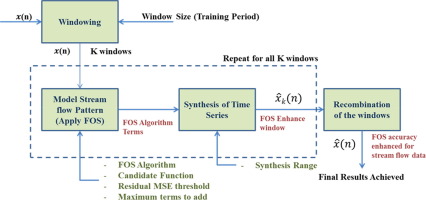当前位置:
X-MOL 学术
›
J. Hydrol.
›
论文详情
Our official English website, www.x-mol.net, welcomes your feedback! (Note: you will need to create a separate account there.)
Adaptive Fast Orthogonal Search (FOS) Algorithm for Forecasting Streamflow
Journal of Hydrology ( IF 6.4 ) Pub Date : 2020-07-01 , DOI: 10.1016/j.jhydrol.2020.124896 Abdalla Osman , Haitham Abdulmohsin Afan , Mohammed Falah Allawi , Othman Jaafar , Aboelmagd Noureldin , Firdaus Mohamad Hamzah , Ali Najah Ahmed , Ahmed El-shafie
Journal of Hydrology ( IF 6.4 ) Pub Date : 2020-07-01 , DOI: 10.1016/j.jhydrol.2020.124896 Abdalla Osman , Haitham Abdulmohsin Afan , Mohammed Falah Allawi , Othman Jaafar , Aboelmagd Noureldin , Firdaus Mohamad Hamzah , Ali Najah Ahmed , Ahmed El-shafie

|
Abstract Data-driven models for streamflow forecasting have attracted considerable attention, as they are independent of physical system features. The physical features of the river basin are extremely hard to collect, especially for large rivers. Empirical data-driven models, such as stochastic and regression models, have been widely used in the field of streamflow forecasting. However, they suffered limited accuracy in predicting extreme streamflow. They also required raw data pre-processing prior to the modeling process, especially for lengthy data records and for large time-scale increments (e.g. monthly resolution). To overcome these challenges, data-driven forecasting models based on Artificial Intelligence (AI) have been widely used and resulted in enhancing the forecasting accuracy. Nevertheless, AI-based models required augmentation with proper optimization schemes to adjust the model parameters for optimal accuracy. Furthermore, in some cases, due to unsuitability of the optimization model, there is high possibility for overfitting of the AI model, which might cause poor prediction of input patterns that were not adequately mimicked. This study introduces a new approach to streamflow forecasting based on nonlinear system identification. The proposed technique employs Fast Orthogonal Search (FOS) to develop a nonlinear model of stream flow. The main advantage of using FOS is eliminating the requirement of raw data pre-processing and the need for an optimization scheme for model parameter adjustment since the FOS algorithm takes this into account while building the model. In addition, the FOS algorithm includes a pole-zero cancellation procedure that can detect and avoid the over-fitted models. The FOS-based nonlinear modeling approach was adopted in this research for the development of a streamflow forecasting model at Aswan High Dam using monthly basis natural streamflow records for 130 years. The results indicated that the proposed FOS algorithm outperformed the previously developed AI models of streamflow forecasting for large data records and for large time-scale increment (monthly resolution).
中文翻译:

用于预测水流的自适应快速正交搜索 (FOS) 算法
摘要 流量预测的数据驱动模型由于独立于物理系统特征而引起了广泛的关注。流域的物理特征极难收集,尤其是大河流。经验数据驱动模型,如随机模型和回归模型,已广泛应用于流量预测领域。然而,他们在预测极端水流方面的准确性有限。他们还需要在建模过程之前对原始数据进行预处理,特别是对于冗长的数据记录和大的时间尺度增量(例如每月分辨率)。为了克服这些挑战,基于人工智能(AI)的数据驱动预测模型已被广泛使用,并提高了预测的准确性。尽管如此,基于 AI 的模型需要通过适当的优化方案进行扩充,以调整模型参数以获得最佳精度。此外,在某些情况下,由于优化模型的不适用性,AI 模型过拟合的可能性很高,这可能会导致对未充分模仿的输入模式的预测不佳。本研究介绍了一种基于非线性系统辨识的水流预测新方法。所提出的技术采用快速正交搜索 (FOS) 来开发水流的非线性模型。使用 FOS 的主要优点是消除了原始数据预处理的要求和模型参数调整优化方案的需要,因为 FOS 算法在构建模型时考虑了这一点。此外,FOS 算法包括一个零极点消除程序,可以检测和避免过拟合模型。本研究采用基于 FOS 的非线性建模方法,使用 130 年的月基础自然流量记录开发阿斯旺高坝的流量预测模型。结果表明,所提出的 FOS 算法优于先前开发的用于大数据记录和大时间尺度增量(每月分辨率)的流预测 AI 模型。
更新日期:2020-07-01
中文翻译:

用于预测水流的自适应快速正交搜索 (FOS) 算法
摘要 流量预测的数据驱动模型由于独立于物理系统特征而引起了广泛的关注。流域的物理特征极难收集,尤其是大河流。经验数据驱动模型,如随机模型和回归模型,已广泛应用于流量预测领域。然而,他们在预测极端水流方面的准确性有限。他们还需要在建模过程之前对原始数据进行预处理,特别是对于冗长的数据记录和大的时间尺度增量(例如每月分辨率)。为了克服这些挑战,基于人工智能(AI)的数据驱动预测模型已被广泛使用,并提高了预测的准确性。尽管如此,基于 AI 的模型需要通过适当的优化方案进行扩充,以调整模型参数以获得最佳精度。此外,在某些情况下,由于优化模型的不适用性,AI 模型过拟合的可能性很高,这可能会导致对未充分模仿的输入模式的预测不佳。本研究介绍了一种基于非线性系统辨识的水流预测新方法。所提出的技术采用快速正交搜索 (FOS) 来开发水流的非线性模型。使用 FOS 的主要优点是消除了原始数据预处理的要求和模型参数调整优化方案的需要,因为 FOS 算法在构建模型时考虑了这一点。此外,FOS 算法包括一个零极点消除程序,可以检测和避免过拟合模型。本研究采用基于 FOS 的非线性建模方法,使用 130 年的月基础自然流量记录开发阿斯旺高坝的流量预测模型。结果表明,所提出的 FOS 算法优于先前开发的用于大数据记录和大时间尺度增量(每月分辨率)的流预测 AI 模型。


























 京公网安备 11010802027423号
京公网安备 11010802027423号